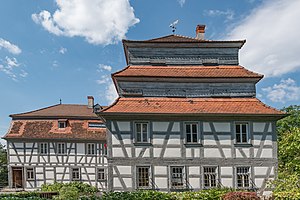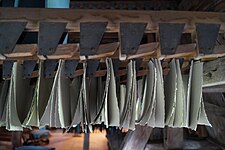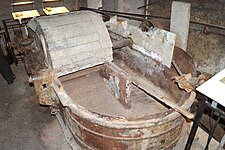Homburg paper mill
| Homburg paper mill
|
||
|---|---|---|
| Location and history | ||
|
|
||
| Coordinates | 49 ° 47 '38 " N , 9 ° 37' 34" E | |
| Location | Homburg am Main | |
| Waters | Bischbach | |
| Built | 1807 | |
| Shut down | 1975 | |
| Status | used as a museum | |
| technology | ||
| use | Paper mill | |
| drive | Watermill | |
| Website | www.papiermuehle-homburg.de | |
The Homburg paper mill , built in 1807, is located in the Homburg am Main district of the market town of Triefenstein . It was in operation for the production of paper and cardboard until 1975 and was renovated as a paper mill museum from 1994 to 1997 . The production facilities with original machines and equipment have been preserved.
history
The beginnings (hand paper production)
In 1806 the paper miller Leonhard Leinziger decided to give up his business in nearby Windheim due to the temporary lack of water in the Hafenlohr , to dismantle the mill there and to move it to Homburg. In November 1806 he received approval from the Homburg regional court to found the paper mill in Homburg. The Bischbach , which rises not far from the mill building, was ideally suited for milling operations, as it supplied sufficient quantities of clean spring water all year round that did not freeze even in winter. The water served both as process water and to drive the water wheel system. At the same time, the Grand Duchy of Würzburg offered a sufficiently large sales market.
- “The consumption of paper has risen sharply in the provinces, even in the provinces, among prolific writers of all kinds, and there is also no lack of common material from rags. Therefore, paper mills 10 with 50 workers and one of Product 22377 consist fl. ; of which for 2463fl. go abroad again. "
The fiber raw material for the paper of the 19th century mainly fabric scraps (were until mid Hader ) from linen , hemp or cotton used by rag-pickers collected and sorted at the paper mill, washed and were crushed. In order to ensure the supply of the coveted raw material, bans on the export of rags were even issued. On the other hand, the processing of unsanitary textile waste posed a risk for paper mill workers to suffer from infectious diseases such as anthrax , typhus or cholera . In particular, the health of women engaged in rag sorting was at risk. Therefore, infected textiles should be incinerated in accordance with health regulations, even though this involved a reduction in the amount of raw materials.
- “The export of rags is prohibited by law. One should therefore think that there is enough material in the country without it being necessary to bring in from abroad. But many rags are used as manure and therefore withdrawn from the paper mills; In addition, with stricter supervision by the health police, many old canvases and clothes that were previously brought to the paper mills are burned to reduce infection. For the same reason, however, the strictest supervision should also be kept on bringing in rags from abroad "
The papers produced were still hand-made at that time. In 1823, Leiniger's son Conrad set up a sales point in Würzburg and offered "all types" of Homburg's "paper products for sale at extremely cheap prices in the best quality in bales, tears and books" . From 1853, the subsequent owner of the paper mill, Johann Follmer, has published a “calculation book” that provides information on the paper quality produced. It lists writing and printing papers of various qualities, packing papers, but also tobacco paper.
Buildings, mill moat and mill wheel
The paper mill building, which dates back to 1807, is a two-story, two-wing building in half-timbered construction over a high basement. The entrance to the museum is also located here. The main building is equipped with a three-tier hipped roof , with the windows to the two drying floors between the individual roof tiers. The side wing is equipped with a mansard half-hipped roof. Measurements of the age of the woodwork used for the framework with the help of the radiocarbon method show that this comes from an older mill.
The outbuilding from the 19th century, a two-storey quarry stone building with sandstone frames and a gable roof, now serves as a venue for celebrations. Changing exhibitions also take place here. A covered connecting corridor leads to the main building on the upper floor.
The upper mill ditch fed by the spring dates from the beginning of the 19th century and mostly runs in a canal. Partly this is led over a bridge construction. It ends directly above the mill wheel in a channel in which the direction of flow of the water is deflected. The water flowing out from the underside thus drives the iron mill wheel in a reverse direction. This has the advantage that less splashing water forms on the path in front of the water wheel.
The waterwheel was originally used to drive the pan mill -millstones for crushing the fibers. The mill ditch also supplied the paper mill with clean process water for washing the rags and for dispersing the pulp. Later, the machines for making cardboard were also powered by water power. Today the waterwheel is mainly used for regenerative energy generation, with an electric generator generating 4.5 kilowatts of electricity and feeding it into the public grid. However, it continues to drive the system during museum presentations.
Mechanical cardboard production
With the increasing consumption of paper, wood pulp and cellulose expanded the raw material base. In addition, with the invention of the paper machine and the large paper mills associated with it, there began significant competition for the small paper mills. The Follmersche Mühle had sufficient capital through the associated, sizable agricultural operation to secure the existence of the mill by investing a simple cylinder mold and to specialize in cardboard production. Due to its compact design, the machine could be set up without structural expansion of the production facility. The machine was built in 1883 by the Joachim & Sohn machine factory in Schweinfurt . Depending on the type of machine, in the Schweinfurt price list from 1900 the cylinder machine prices fluctuate between 1875 and 2600 marks. Compared to the previous value of Follmer's possessions, which were quoted at 30,000 marks in 1887, it was a substantial investment.
The finished scooped sheets of paper were placed on linen in the attic to dry or hung with special clips. This work was mostly done by children. Special ventilation flaps ensured sufficient air exchange.
Before the Second World War, the mill specialized in the production of folders and wrapping paper. In 1955, the Homburg range consisted of colored, embossed cardboard, colored folders and ribbed hand-made folder covers.
In the case of the latter, a special cylinder mold imitated the ribbing in the cardboard caused by the hand-scooped arches. While the mechanical folder production continued until the closure in 1975, the production of wrapping paper was discontinued soon after 1955.
Since the paper mill was founded until 1975, the paper was dried in the attics. The entire drying floor facility with paper clips, drying rods and hemp rope covering is preserved there. In order to be able to work independently of the capacity of the drying floors and the weather, Johann Hermann, the son of Johann Follmer, had a heated, separate drying hall built in 1913. Today only plans survive the structural form of the building, as the hall was demolished after production was stopped.
The folders were smoothed in a satin finishing machine equipped with two cylinder rollers. In a wooden screw press with two pressing devices, which had already been part of the pre-industrial workshop equipment, the satin-finished files were pressed until 1975. A format cutting machine from the 1930s, which was acquired in the 1950s, was used to trim the folder.
Homburg folder and cover box were sold both throughout Germany and abroad. Domestic customers of the paper mill were, in addition to paper wholesalers, for example the Würzburg State Archives, loose-leaf binder factories and the printing works of the penal institution in Straubing. In 1956, a Hamburg paper exporter requested the delivery of the "extra tough colored, air-dried hand-made folder" expressly in "seaworthy full board packaging". These were made in a small workshop in the mill building and exported to Venezuela in 1956 as Homburger envelope boxes. In 1960 the “Skandinaviska Etuifarbiken” in Malmö requested an offer for ten tons of envelope and folder cardboard. The quality of the wrapping cardboard produced on the cylinder mold machine was appreciated because it was not glued, "but rather tough and well-glued".
Although the production of hand paper was never completely stopped, the mill specialized more and more in the production of folder and wrapping paper. The manufacture of wrapping paper was discontinued in 1955, while the mechanical folder production continued until the plant was closed. After 186 years, the Homburg paper mill ceased operations in 1975. The two most important reasons for the closure were the comparatively labor-intensive production method and higher requirements for wastewater disposal, so that a new sewage treatment plant would have been necessary, for which there was no space and no means available.
The Homburg Paper Mill Museum
After the decommissioning in 1975, the building was placed under a preservation order (file no. D-6-77-154-6), but renovation did not begin until almost 20 years later. In the meantime, the Follmer family continued to look after the building. Great emphasis was placed on being true to the original. The original equipment from pre-industrial production such as the water wheel, drying floor and wooden screw press have been preserved, as have the functional machines for making cardboard. After a three-year renovation phase, the paper mill was opened in 1997 as a museum of the history of technology. In addition to the old production facilities, it shows the working and living situation at the time of the shutdown.
Based on the historical machines and equipment, the entire manufacturing process at the time of the shutdown can still be traced today (2018) . There are both pre-industrial facilities such as the water wheel drive, the drying floors and a wooden screw press, as well as industrial machines. In the authentically preserved production rooms, information is clearly given about manufacturing processes, working life and the workplace situation in the paper mill. The museum presentation also includes the environment of the people who worked and lived in the mill. Your living spaces have been preserved in their original condition when the company closed down. Documentation exhibitions on the various paper raw materials, watermarks and pre-industrial hand paper production complete the exhibition.
Today's hand paper production
The papermaker Johannes Follmer , the youngest member of the paper mill family, is continuing the papermaking tradition that has existed in Homburg for almost two centuries in the fifth generation in the 21st century. The decision to work with paper developed out of the long-standing family tradition, which is to be given new status through further development of the products and manufacturing methods. The young papermaker acquired the necessary basic knowledge from various masters. This included, among other things, a stay of several weeks at the Gmund handmade paper factory and basic studies at the Gernsbach papermaking school near Baden-Baden .
In the outbuilding of the museum he runs a modern papermaking workshop. Classic papermaking is experiencing a renaissance there: every sheet of handmade paper is scooped by hand and air-dried as it was back then. The paper differs from the machine-made papers by its finely grained surface and four-sided deckle edge. The basis for paper production in his workshop is provided by historical and modern ladle screens, various presses and a paper dutchman for processing the fibers. High-quality raw materials are used today, depending on the desired paper properties. In addition to textile scraps, various fibers are used: cotton, flax, hemp or abaca. Colored papers are colored with pigments, mottles and inclusions in the handmade paper complete the range of different types of paper. Papers for high-quality prints are also produced. In collaboration with various artists, large arches with artistically designed watermarks are created by hand.
Bringing hand-made paper closer to a broad audience in its original setting is one of the goals pursued by the Homburg papermaker. Paper should regain importance as an independent medium. The Homburg papermaking tradition strives to continue even in the computer age and defy the new zeitgeist through craftsmanship.
Web links
- www.papiermuehle-homburg.de
- The story of a paper mill. In: Youtube. ITVvideos, October 23, 2012, accessed August 27, 2018 .
Notes and individual references
- ^ Friedrich von Hößle: Bavarian paper history. In: The paper manufacturer. Book 41 (1925), p. 653
- ^ Leonhard Scherg : The Homburg paper mill. In: Municipality of Markt Triefenstein (ed.): Homburg am Main. 1200 years of Hohenburg. 880 years of Kallmuth viticulture. 550 years of the city of Homburg. Würzburg 1982, p. 140. The approval certificate of the Homburg regional court, which according to Hößle's statements had been issued on November 15, 1806, has not yet been viewed.
- ↑ Philip Heffner: Report of the royal state administration in Würzburg to the royal court commission on the budget year 1814/15. Published in: Anton Chroust: Dem Würzburger Lande. For the centenary of its union with the Kingdom of Bavaria. Würzburg 1914, p. 127.
- ^ A b Anton Chroust: Würzburger Lande. For the centenary of its union with the Kingdom of Bavaria. Würzburg 1914, p. 127
- ^ Intelligence sheet for Lower Franconia and Aschaffenburg of the Kingdom of Bavaria, p. 504.
- ↑ a b c d e Annette Späth (Ed.): Museum Paper Mill Homburg. With contributions by Ernst Bielefeld, Johannes Follmer, Hubert Köhler and Kilian Kreilinger. Weltkunst Verlag, Munich 1999, ISBN 978-3-422-01026-0 .
- ↑ Price list for paper and cardboard and wood pulp manufacturing machines etc. of the machine factory, iron foundry & boiler forge C. Joachim & Sohn Schweinfurt a. Main. January 1, 1900, p. 31.
- ^ Letter from Max Follmer to the Military Government with a request to restart production; without year. Privately owned.
- ↑ Bill of December 7, 1955 addressed to the paper mill by Darmstädter Verlagsgesellschaft, which concerns the advertisement of the Homburg paper mill in the "ABC of German Economy". Privately owned.
- ↑ Information from the Späth family.
- ^ Letter from Josef P. Hilgers, Paper-Export-Import, to the Joh. Follmer paper factory dated May 8, 1956. Private ownership.
- ^ Letter from the Hamburg company G. Schürfeld & Co. From July 20, 1956 to the Johann Follmer paper mill. Privately owned.
- ^ Letter from the Skandinaviska Etuifabriken in Malmö dated August 13, 1960 to the Johann Follmer paper mill. Privately owned.













